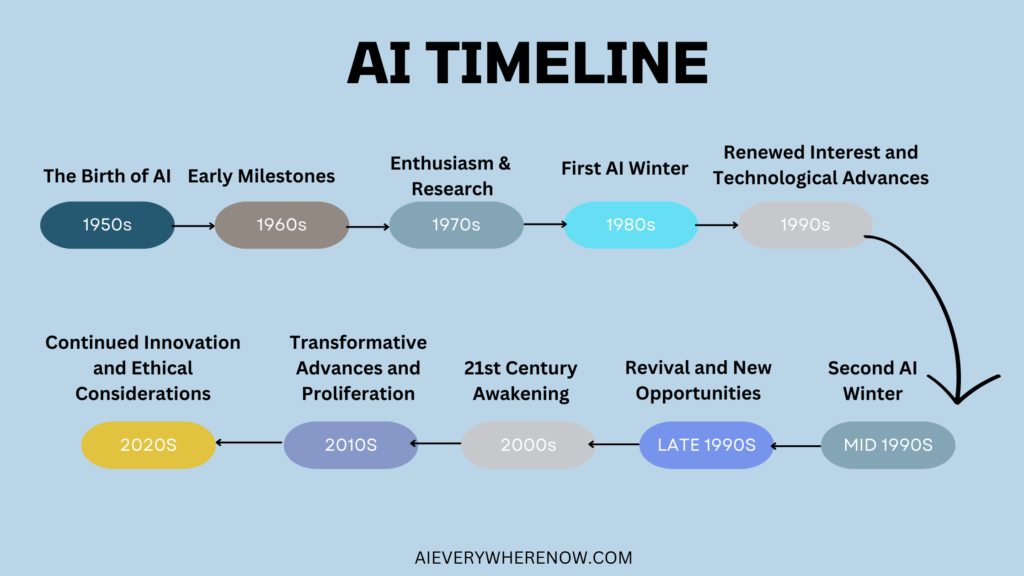By: M. Vazquez
3/28/2024

While it may seem like AI has suddenly emerged and become pervasive in various aspects of our lives, the reality is that AI research and development have been ongoing for more than six decades. The term “Artificial Intelligence” was coined in 1956, and since then, there has been continuous progress in the field, although the pace of advancement has varied. It’s common for technological breakthroughs to gain significant attention once they reach a certain level of maturity and practical application, which might contribute to the perception of AI as a recent discovery. However, acknowledging its long history helps provide context and understanding of the evolution of AI as a field and its current capabilities.
To better understand how AI has evolved over the years, here is a simplified timeline of key milestones and developments in the field of artificial intelligence:

1950s:
- 1950: Alan Turing proposes the Turing Test as a measure of machine intelligence.
- 1956: John McCarthy coins the term “artificial intelligence” and organizes the Dartmouth Conference, which is considered the birth of AI as a field of study.
1960s:
- 1969: The first working prototype of a mobile robot, Shakey the Robot, is developed at the Stanford Research Institute.
1970s:
- 1973: The development of the LISP programming language, which becomes widely used in AI research.
- 1979: The publication of the book “Gödel, Escher, Bach” by Douglas Hofstadter, which explores the connections between AI, mathematics, and human cognition.
1980s:
- 1980: The first commercial expert system, XCON, is developed by Edward Feigenbaum and colleagues at Stanford University.
- 1985: The emergence of backpropagation as a method for training artificial neural networks, leading to significant progress in the field of deep learning.
1990s:
- 1997: IBM’s Deep Blue defeats world chess champion Garry Kasparov in a six-game match, marking a significant milestone in AI and machine learning.
- 1999: The founding of the field of bioinformatics, which applies AI techniques to biological data analysis and research.
2000s:
- 2006: Geoffrey Hinton and colleagues publish a paper on deep learning that revitalizes interest in neural networks and sets the stage for rapid progress in the field.
- 2009: The launch of Siri, Apple’s virtual assistant, which popularizes the use of natural language processing and voice recognition in consumer products.
2010s:
- 2012: The ImageNet competition is won by a deep convolutional neural network, demonstrating the effectiveness of deep learning in image recognition tasks.
- 2014: Google’s DeepMind team develops AlphaGo, an AI program that defeats a human Go champion for the first time.
- 2017: The emergence of generative adversarial networks (GANs), a class of AI algorithms used for generating realistic images and other data.
- 2019: The development of large language models like OpenAI’s GPT (Generative Pre-trained Transformer), which achieve human-level performance on a range of natural language processing tasks.
2020s (up to January 2022):
- Continued advancements in AI, including applications in healthcare, finance, autonomous vehicles, and robotics.
- Growing concerns about the ethical implications of AI, including issues related to bias, privacy, and job displacement.
- Increased research focus on AI safety and alignment, aiming to ensure that AI systems behave in ways that are beneficial and aligned with human values.
As you can see this timeline provides a high-level overview and does not cover every development in the field of AI.
AI winters
over the years there were some periods known as AI winters.
The term “AI winters” refers to periods of reduced funding, interest, and progress in the field of artificial intelligence (AI). These periods are characterized by a downturn in enthusiasm and investment due to unmet expectations, lack of practical applications, or technological limitations. The two most notable AI winters occurred:
- First AI Winter (1970s-1980s): Following significant initial enthusiasm and funding in the late 1950s and 1960s, AI research faced skepticism and criticism in the 1970s and 1980s due to overpromising and underdelivering on the capabilities of AI systems. Funding agencies and investors became disillusioned with the field, leading to reduced funding and a decline in AI research activities.
- Second AI Winter (late 1980s-early 1990s): The second AI winter was prompted by similar factors as the first, including unmet expectations and a lack of significant progress in AI technology. Additionally, the commercial failure of expert systems, coupled with a general economic downturn, contributed to a further decline in funding and interest in AI research during this period.
Despite these setbacks, AI research eventually rebounded, driven by advances in computational power, algorithms, and data availability, and now we can see AI almost everywhere.


